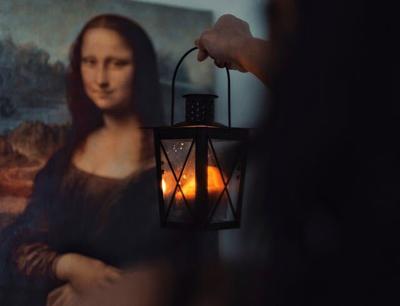Art has always been a powerful medium for human expression, and some paintings have transcended their time to become iconic symbols of creativity and cultural significance. Let's embark on a journey through some of the most famous paintings in history, uncovering the stories behind them and exploring their impact on art and society
Mona Lisa – Leonardo da Vinci

No discussion of famous paintings would be complete without mentioning Leonardo da Vinci's "Mona Lisa." Painted in the early 16th century, this portrait of Lisa Gherardini, the wife of a wealthy Florentine merchant, is renowned for its enigmatic expression and masterful use of sfumato, a technique that creates a soft transition between colors and tones. The "Mona Lisa" has captivated audiences with her mysterious smile and has become a symbol of Renaissance art. Housed in the Louvre Museum in Paris, this painting draws millions of visitors annually, intrigued by its artistic brilliance and the mystique of its subject.
Starry Night – Vincent van Gogh
Vincent van Gogh's "Starry Night," created in 1889, offers a mesmerizing glimpse into the artist's turbulent mind. This post-impressionist masterpiece depicts a swirling night sky over a quiet village, with bold, expressive brushstrokes and vivid colors. Van Gogh painted this work while he was in the Saint-Paul-de-Mausole asylum in France, reflecting both his emotional turmoil and his fascination with the cosmos. The painting is now housed at the Museum of Modern Art in New York City and remains one of the most beloved and recognizable works in art history.
The Persistence of Memory – Salvador Dalí
Salvador Dalí's "The Persistence of Memory," painted in 1931, is a quintessential example of surrealism. The painting features melting clocks draped over a desolate landscape, challenging perceptions of time and reality. Dalí's work invites viewers to ponder the fluidity of time and the nature of dreams, reflecting the psychological and philosophical explorations characteristic of surrealist art. This iconic piece is part of the collection at the Museum of Modern Art in New York and continues to inspire interpretations and discussions about the nature of consciousness.
The Birth of Venus – Sandro Botticelli
Sandro Botticelli's "The Birth of Venus," painted in the late 15th century, is a stunning example of early Renaissance art. This mythological painting depicts the goddess Venus emerging from the sea, standing on a shell. Botticelli's use of graceful lines and harmonious composition, along with the incorporation of classical themes, makes this work a masterpiece of the Renaissance era. The painting is housed in the Uffizi Gallery in Florence, Italy, where it remains a symbol of ideal beauty and classical mythology.
Guernica – Pablo Picasso
Pablo Picasso's "Guernica," painted in 1937, is a powerful political statement against the horrors of war. This monumental work was inspired by the bombing of the Basque town of Guernica during the Spanish Civil War. Picasso's use of monochromatic tones and distorted forms conveys the chaos and suffering caused by conflict. The painting's raw emotional impact and its commentary on human suffering have cemented its place as a significant work of modern art. "Guernica" is displayed in the Museo Reina Sofia in Madrid.
The Night Watch – Rembrandt van Rijn
Rembrandt van Rijn's "The Night Watch," completed in 1642, is one of the most famous group portraits from the Dutch Golden Age. The painting depicts a militia company in motion, led by Captain Frans Banning Cocq and his lieutenant, Willem van Ruytenburch. Rembrandt’s innovative use of light and shadow, along with his dynamic composition, brings the scene to life, capturing a moment of civic pride and camaraderie. "The Night Watch" is housed in the Rijksmuseum in Amsterdam and is celebrated for its dramatic portrayal and technical mastery.
These masterpieces not only showcase the incredible talent of their creators but also offer windows into the cultural, emotional, and historical contexts of their times. From the enigmatic "Mona Lisa" to the haunting imagery of "Guernica," each painting provides a unique perspective on the human experience. As we explore these iconic works, we gain a deeper appreciation for the diverse ways in which art can capture and reflect the essence of our world.


(0) comments
We welcome your comments
Log In
Post a comment as Guest
Keep it Clean. Please avoid obscene, vulgar, lewd, racist or sexually-oriented language.
PLEASE TURN OFF YOUR CAPS LOCK.
Don't Threaten. Threats of harming another person will not be tolerated.
Be Truthful. Don't knowingly lie about anyone or anything.
Be Nice. No racism, sexism or any sort of -ism that is degrading to another person.
Be Proactive. Use the 'Report' link on each comment to let us know of abusive posts.
Share with Us. We'd love to hear eyewitness accounts, the history behind an article.